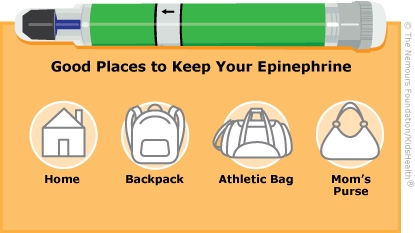After Anaphylaxis: How to Care for Your Child
Anaphylaxis can be life-threatening. Make sure your child and all caretakers know what to do in an emergency. Your child should have two epinephrine auto-injectors available at all times.


Anaphylaxis is a severe allergic reaction. The most common allergens (things that cause a reaction) are foods, medications, and insect stings.
Common anaphylaxis symptoms are itchy or red skin, hives (welts), swelling, trouble breathing, hoarse voice, itchy throat, a runny or stuffed nose, throwing up, a fast heartbeat, and dizziness or passing out. If a child has anaphylaxis more than once, the signs might be different each time.
Treatment for anaphylaxis includes an injection of epinephrine (adrenaline) right away. Other medications like prednisone (a steroid) and antihistamines treat the reaction and will usually be continued for a few days. Sometimes symptoms return without another exposure to the allergen, usually within 10 hours, but some can be up to 3 days later. After severe reactions, health care providers will observe kids in the hospital so they get prompt care if the reaction comes back.
During your child's hospital stay, the care team treated the anaphylaxis and its effects. Your child's breathing, heartbeat, and other bodily functions are back to normal. Your child was carefully observed for a return of the reaction and is now safe to go home.
You received an allergy action plan about warning signs and when to use epinephrine. Epinephrine comes in an auto-injector. If your child has anaphylaxis again, the medicine should be injected immediately.

-
Give your child any prescription or over-the-counter medications as directed by your health care provider.
-
Fill your child's prescription for the epinephrine auto-injectors right away.
-
Always be prepared for a reaction. Keep two epinephrine auto-injectors with your child at all times, including at school, childcare, and activities. Make sure the epinephrine auto-injectors have not expired. Avoid exposure to extreme temperatures (too hot or too cold) and sunlight. All caregivers should know how to use the auto-injector. Talk with your health care provider about how to recognize the signs of an allergic reaction.
-
Your child should stay away from the anaphylaxis trigger.
-
Make sure your child knows the early warning signs of anaphylaxis and what to do if they happen.

-
Make a follow-up appointment with an allergist to create a plan to manage your child's allergy.
-
Your child should always wear a medical alert ID bracelet stating the name of the allergen. You can buy one in a drugstore or online.

-
You're not sure how to use the epinephrine injector.
-
Your child has side effects from any medication taken for the allergic reaction.
-
Your child is injected with epinephrine by accident.

If your child shows signs of anaphylaxis, including difficulty breathing, throat tightness, dizziness, a combination of two mild symptoms (such as hives with vomiting), or loss of consciousness, follow these steps, in this order:
-
Immediately use the epinephrine auto-injector on your child. Give the epinephrine even if you're not sure your child needs it. It won't do any harm. After getting the epinephrine, your child must go to the ER to see if any additional treatment is needed. This is true even if your child is doing better, because there can be a second wave of symptoms.
-
Call 911.
-
If someone is with you, have that person call 911 and tell the person your child is experiencing a life-threatening emergency.
-
If you're alone, give epinephrine first, then immediately call 911 and say your child is experiencing a life-threatening emergency.
-
Lay your child down with his or her legs elevated while you wait for the ambulance.
-
Don't take your child to the ER in a car. Wait for an ambulance with trained specialists to transport your child.
-
Take the used epinephrine auto-injector to the hospital with you.